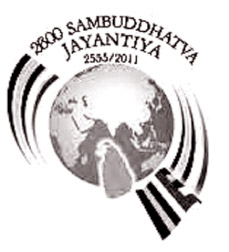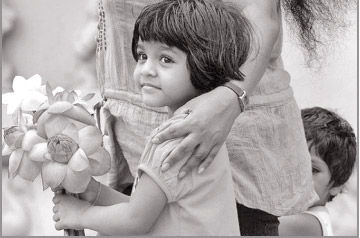|
Celebrating 2600 years of the Buddha’s Enlightenment:
Essential understanding needed to practise the Dhamma
By Col. Sudath MADUGALLE
 For countless eons the Bodhisatva practised to achieve the 10
perfections of Dana (generosity), Sila (virtue), Nekkhamma
(renunciation), Pangnga (wisdom), Viriya (effort), Kshanthi (tolerance),
Satya (truthfulness), Adittana (determination), Metta (compassion) and
Upekkha (imperturbability). It was these perfections that provided
support in his realisation of the four Noble Truths. When Mara, the Lord
of Death appeared to distract the meditating ascetic under the
Bodhi-Tree, determined to realise the Truth that led to the cessation of
all suffering, it was the perfections that supported the Bodhisatva to
vanquish Mara. As this realisation of the Truth was achieved without
outside help the Buddha is known as Samma Sambuddha - the Supreme Being
who realised the Truth through his own effort. The Buddha was no
messenger of another’s knowledge or realisation. He was the knower of
all things that needed to be known in the entire world. His teachings
were based on the authentic experience he had of the path to
realisation. For countless eons the Bodhisatva practised to achieve the 10
perfections of Dana (generosity), Sila (virtue), Nekkhamma
(renunciation), Pangnga (wisdom), Viriya (effort), Kshanthi (tolerance),
Satya (truthfulness), Adittana (determination), Metta (compassion) and
Upekkha (imperturbability). It was these perfections that provided
support in his realisation of the four Noble Truths. When Mara, the Lord
of Death appeared to distract the meditating ascetic under the
Bodhi-Tree, determined to realise the Truth that led to the cessation of
all suffering, it was the perfections that supported the Bodhisatva to
vanquish Mara. As this realisation of the Truth was achieved without
outside help the Buddha is known as Samma Sambuddha - the Supreme Being
who realised the Truth through his own effort. The Buddha was no
messenger of another’s knowledge or realisation. He was the knower of
all things that needed to be known in the entire world. His teachings
were based on the authentic experience he had of the path to
realisation.
The process of the Bodhisatva’s realisation of the Truth highlights
one key ingredient in the path to cessation of all suffering. The
determination, commitment and effort to cease all suffering must be
personal. The enthusiasm, effort and commitment of others do not lead to
personal liberation. However, the significant advantage and support
available to us is the living teachings - the Dhamma the Buddha
expounded.
 Undoubtedly the Buddha is the most influential teacher of this world.
His intention was to enable all beings to realise the Truth that He
himself had realised. He emphasised on the importance of practising the
Dhamma so that it became a personal experience. Undoubtedly the Buddha is the most influential teacher of this world.
His intention was to enable all beings to realise the Truth that He
himself had realised. He emphasised on the importance of practising the
Dhamma so that it became a personal experience.
As such the Buddha never imposed restrictions on the faculty of
thinking of those who wished to understand the Dhamma. He only offered
guidance reminding that the Buddha was only a guide and only offered
guidance, that reading the path, making effort was the responsibility of
the individual.
Contemporary India boasted of many eminent teachers beside the
Buddha. Some even claimed to be the Buddha themselves. However as they
had not realised the Four Noble Truths, in explaining their teachings
they had to impose restrictions and prevent followers from asking
questions. If followers had been granted full freedom of questioning,
they would not have been able to maintain their position in the society
enjoying the worldly comforts offered by their followers.
In complete contrast to these teachers, the Buddha always maintained
a policy of open inquiry with everyone who wished to speak with him.
The Buddha said one must follow only the teachings that he had tested
by practising and understood to be wholesome. To the Kalamas of
Kesaputta who questioned the Buddha as to how they may know the Truth as
all teachers maintained that each one of them expounded the Truth, the
Buddha responded, “Kalamas under no circumstance should one believe
something because it was said to one by an eminent teacher or it was
traditional knowledge or common sense. Nor should one believe something
because it was found in a holy book or it seemed like the Truth and it
suited one’s own theories.
“Should one realise an action to be wholesome through one’s own
experience, then only should one believe such to be the Truth. How could
one know an action to be wholesome and skillful? Should one realise an
action to be beneficial to self and others, non harmful to self and
others, only such actions are wholesome and skilful. Only in such
actions should one engage.”
The Buddha said that the Dhamma had the quality of being able to be
held under scrutiny and be proven as the Truth. This Ehi Passiko quality
of the Dhamma invited inquiry, examination and scrutiny. The Truth and
the purity of the teachings can be known only through experience.
Experience is possible only through practice. That which is heard and
told and seen must be tested through practice to be experienced as
wholesome and skilful.
 The teaching of the Buddha, the Dhamma, does not encourage blind
faith or belief. The Truth of the teaching is realised only through
experience. Leadership for one’s life lies with each individual being.
It is not a power or responsibility that can be vested on an outside
source. As such the Buddha’s teaching encourages beings to exercise
wisdom and experience in leading daily life. The teaching of the Buddha, the Dhamma, does not encourage blind
faith or belief. The Truth of the teaching is realised only through
experience. Leadership for one’s life lies with each individual being.
It is not a power or responsibility that can be vested on an outside
source. As such the Buddha’s teaching encourages beings to exercise
wisdom and experience in leading daily life.
The Buddha allowed unsurpassable freedom to question, debate and
discuss the teachings. Upali Sutta is a fine example of this freedom
granted to beings to question and interact with the Dhamma. Upali was a
staunch lay follower and supporter of Mahaweera, the Jain teacher of
eminence.
Once he approached the Buddha claiming to the world that he would
vanquish the Buddha through argumentation. However, being a very
intelligent man, upon discussion with the Buddha, he realised the
futility of the Jain practice of extreme asceticism and begged to be
allowed to be a robed disciple of the Buddha.
The Buddha however discouraged Upali of becoming a monk, reminding
him of his position within the Jain community and the impact of his
decision on the Jain religion and his teacher Mahaweera.
In Chullahattipadopama Sutta, the Buddha used the smile of the
footprint of the elephant to encourage inquiry and further inquiry
before accepting something as the Truth. The Buddha said just by seeing
the footprint of an elephant one must not decide on its size and power,
that one must see the elephant before one decided on the size and nature
of the elephant. Similarly with the teachings too, the Buddha said only
inquiry and direct experience would enable the realisation, the seeing
which ultimately led to liberation.
The Buddha allowed inquiry and scrutiny of the teachings as a means
of eradicating doubt. Even on His death bed on the occasion of the
Parinibbana, the Buddha invited the monks to come forward should there
be one with any doubts in the Dhamma. He advised the monks that should
any doubt or confusion occur regarding the Dhamma, that such doubts
should be eradicated through discussion with noble ones who had
experienced the Truth.
In the Maha Parinibbana Sutta in the Digha Nikaya, the Buddha
specified 4 ways in which doubt in the teaching should be eradicated.
“Should a monk claim that this is the Truth I heard from the Buddha
Himself, that I clarified with Noble monks living in such and such
monastery, that I clarified with virtuous, erudite monks of such and
such a monastery or that I clarified with a virtuous, erudite monk of
such and such a monastery, do not believe him. Practise the teachings
yourself, test the teachings against your own experience.
“If you realise it as beneficial to self and others, non harmful to
self and others, accept and further practise until it leads you to the
ultimate realisation and cessation of all suffering”.
It is clear from this advice given by the Buddha on His dead bed,
that realisation of the Truth can be achieved only through practising
the teaching. Wholesome inquiry leads to the eradication of doubt
allowing wholesome practice. Logic, argumentation, analysys and
preconceived notions are not the means by which the Truth can be
realised.
It is only by experiencing the teaching through one’s practice that
the realisation of the Truth that leads to ultimate liberation can be
achieved.
In this year of Sambuddhatva Jayanthi, celebrating the 2600th Year of
Enlightenment of the Buddha, practise that leads to the cessation of
suffering should be a priority for all Buddhists.
The writer is the Joint Secretary of the All Ceylon Buddhist
Congress. |

